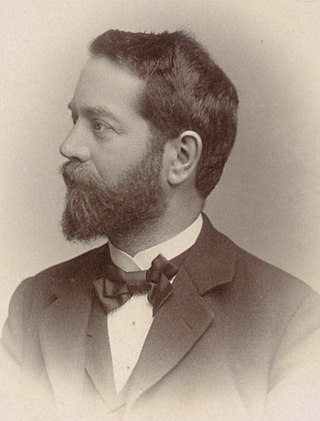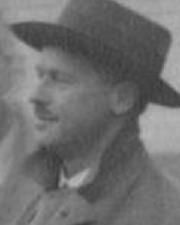
Felix Christian Klein was a German mathematician and mathematics educator, known for his work in group theory, complex analysis, non-Euclidean geometry, and the associations between geometry and group theory. His 1872 Erlangen program classified geometries by their basic symmetry groups and was an influential synthesis of much of the mathematics of the time.

Ludwig Georg Elias Moses Bieberbach was a German mathematician and leading representative of National Socialist German mathematics.
Otto Eduard Neugebauer was an Austrian-American mathematician and historian of science who became known for his research on the history of astronomy and the other exact sciences as they were practiced in antiquity and the Middle Ages. By studying clay tablets, he discovered that the ancient Babylonians knew much more about mathematics and astronomy than had been previously realized. The National Academy of Sciences has called Neugebauer "the most original and productive scholar of the history of the exact sciences, perhaps of the history of science, of our age."
Mathematical Reviews is a journal published by the American Mathematical Society (AMS) that contains brief synopses, and in some cases evaluations, of many articles in mathematics, statistics, and theoretical computer science. The AMS also publishes an associated online bibliographic database called MathSciNet, which contains an electronic version of Mathematical Reviews.
FIZ Karlsruhe — Leibniz Institute for Information Infrastructure, formerly Fachinformationszentrum Karlsruhe, is a not-for-profit company with the public mission to make sci-tech information from all over the world publicly available and to provide related services in order to support the national and international transfer of knowledge and the promotion of innovation. The service institution is member of Gottfried Wilhelm Leibniz Scientific Community, a union of German research institutes. The institute provides information services and infrastructure for the academic and research community and maintains a collection of scientific databases.

Heinrich Adolph Louis Behnke was a German mathematician and rector at the University of Münster.
Abhandlungen aus dem Mathematischen Seminar der Universität Hamburg is a peer-reviewed mathematics journal published by Springer Science+Business Media. It publishes articles on pure mathematics and is scientifically coordinated by the Mathematisches Seminar, an informal cooperation of mathematicians at the Universität Hamburg; its Managing Editors are Professors Vicente Córtes and Tobias Dyckerhoff. The journal is indexed by Mathematical Reviews and Zentralblatt MATH.

Complexity is a peer-reviewed open-access scientific journal covering the field of complex adaptive systems. The journal's scope includes Chaos theory, genetic algorithms, cellular automata, neural networks, evolutionary game theory, and econophysics. It was established in 1995 and is published by John Wiley & Sons.

Helmut Grunsky was a German mathematician who worked in complex analysis and geometric function theory. He introduced Grunsky's theorem and the Grunsky inequalities.

Victor Schlegel was a German mathematician. He is remembered for promoting the geometric algebra of Hermann Grassmann and for a method of visualizing polytopes called Schlegel diagrams.

Erika Pannwitz was a German mathematician who worked in the area of geometric topology. During World War II, Pannwitz worked as a cryptanalyst in the Department of Signal Intelligence Agency of the German Foreign Office colloquially known as Pers Z S. After the war, she became editor-in-chief of Zentralblatt MATH.

Willi Ludwig August Rinow was a German mathematician who specialized in differential geometry and topology. Rinow was the son of a schoolteacher. In 1926, he attended the Humboldt University of Berlin, studying mathematics and physics under professors such as Max Planck, Ludwig Bieberbach, and Heinz Hopf. There, he received his doctorate in 1931. In 1933, he worked at the Jahrbuch über die Fortschritte der Mathematik in Berlin. In 1937, he joined the Nazi Party. During 1937—1940, he was an editor of the journal Deutsche Mathematik. In 1937, he became a professor in Berlin and lectured there until 1950. His lecturing was interrupted because of his work as a mathematician at the Oberspreewerk in Berlin from 1946 to 1949.
Mathematics in Nazi Germany was heavily affected by Nazi policies. Though Jews had previously faced discrimination in academic institutions, the Civil Service Law of 1933 led to the dismissal of many Jewish mathematics professors and lecturers at German universities. During this time, many Jewish mathematicians left Germany and took positions at American universities.
Hans Karl Georg Heinrich Pietsch was a German mathematician who was most notable for being a director of the Mathematical Referat of the Wehrmacht signals intelligence agency, the General der Nachrichtenaufklärung during World War II.
Johann Jakob Burckhardt was a Swiss mathematician and crystallographer. He was an invited speaker at the International Congress of Mathematicians in 1936 in Oslo.

Witold Kazimierz Roter was a mathematician, of the Polish School of Mathematics, expert in differential geometry.

Hermann Ludwig Gustav Wiener was a German mathematician.
A History of Mathematical Notations is a book on the history of mathematics and of mathematical notation. It was written by Swiss-American historian of mathematics Florian Cajori (1859–1930), and originally published as a two-volume set by the Open Court Publishing Company in 1928 and 1929, with the subtitles Volume I: Notations in Elementary Mathematics (1928) and Volume II: Notations Mainly in Higher Mathematics (1929). Although Open Court republished it in a second edition in 1974, it was unchanged from the first edition. In 1993, it was published as an 820-page single volume edition by Dover Publications, with its original pagination unchanged.

Reinhard Siegmund-Schultze is a German historian of mathematics.
Bernd Wegner was a German mathematician. He was the editor-in-chief of Zentralblatt für Mathematik from 1974 until 2011.










